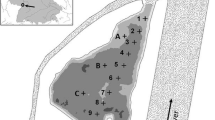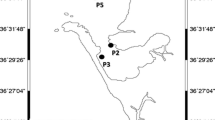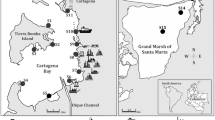Abstract
River sediments may contain a huge variety of environmental contaminants and play a key role in the ecological status of aquatic ecosystems. Contaminants adsorbed to sediments and suspended solids may contribute directly or after remobilization to an adverse ecological and chemical status of surface water. In this subproject of the joint research project DanTox, acetonic Soxhlet extracts from three German river sediments from the River Rhine (Altrip and Ehrenbreitstein with moderate contamination) and River Elbe (Veringkanal Hamburg heavily contaminated) were prepared and redissolved in dimethyl sulfoxide (DMSO). These extracts were analyzed with a standard bioassay battery with organisms from different trophic levels (bacteria, algae, Daphnia, fish) as well as in the Ames test and the umuC test for bacterial mutagenicity and genotoxicity according to the respective OECD and ISO guidelines. In total, 0.01 % (standard) up to 0.25 % (only fish embryo test) of the DMSO sediment extract was dosed to the test systems resulting in maximum sediment equivalent concentrations (SEQ) of 2 up to 50 g l−1. The sediment of Veringkanal near Hamburg harbor was significantly more toxic in most tests compared to the sediment extracts from Altrip and Ehrenbreitstein from the River Rhine. The most toxic effect found for Veringkanal was in the algae test with an ErC50 (72 h) of 0.00226 g l−1 SEQ. Ehrenbreitstein and Altrip samples were about factor 1,000 less toxic. In the Daphnia, Lemna, and acute fish toxicity tests, no toxicity at all was found at 2 g l−1 SEQ. corresponding to 0.01 % DMSO. Only when increasing the DMSO concentration the fish embryo test showed a 22-fold higher toxicity for Veringkanal than for Ehrenbreitstein and Altrip samples, while the toxicity difference was less evident for the Daphnia test due to the overlaying solvent toxicity above 0.05 % dimethyl sulfoxide (DMSO). The higher toxicities observed with the Veringkanal sample are supported by the PAH and PCB concentrations analyzed in the sediments. The sediment extracts of Altrip and Veringkanal were mutagenic in the Ames tester strain TA98 with metabolic activation (S9-mix). The findings allow a better ecotoxicological characterization of the sediments extensively analyzed in all subprojects of the DanTox project (e.g., Garcia-Kaeufer et al. Environ Sci Pollut Res. doi:10.1007/s11356-014-3894-4, 2014; Schiwy et al. Environ Sci Pollut Res. doi:10.1007/s11356-014-3185-0, 2014; Hollert and Keiter 2015). In the absence of agreed limit values for sediment extracts in standard tests, further data with unpolluted reference sediments are required for a quantitative risk assessment of the investigated polluted sediments.


Similar content being viewed by others
References
BfG (2011) Ökotoxikologische Untersuchung von Sedimenten, Eluaten und Porenwässern. BfG-Merkblatt Ökotoxikologische Baggergutuntersuchung. September 2011 http://www.bafg.de/Baggergut/DE/04_Richtlinien/merkblatt_oekotox.html
Boettcher M, Grund S, Keiter S, Kosmehl T, Reifferscheid R, Seitz N, Suares-Rocha P, Hollert H, Braunbeck T (2010) Comparison of in vitro and in-situ genotoxicity in the Danube River by means of the comet assay and the micronucleus test. Mutat Res 700:11–17
Brack W, Schirmer K, Erdinger L, Hollert H (2005) Effect-directed analysis of mutagens and ethoxyresorufin-O-deethylase inducers in aquatic sediments. Environ Toxicol Chem 24:2445–2458
Brack W, Govender S, Schulze T, Krauss M, Hu M, Muz M, Hollender J, Schirmer K, Schollee J, Hidasi A, Slobodnik J, Rabova Z, Ait-Aissa S, Sonavane M, Carere M, Lamoree M, Leonards P, Tufi S, Ouyang X, Schriks M, Thomas K, De Almeida AC, Froment J, Hammers-Wirtz M, Ahel M, Koprivica S, Hollert H, Seiler TB, Di Paolo C, Tindall A, Spirhanzlova P (2013) EDA-EMERGE: an FP7 initial training network to equip the next generation of young scientists with the skills to address the complexity of environmental contamination with emerging pollutants. Environ Sci Eur 25:1–7, http://www.enveurope.com/content/25/1/18
Bräunig J, Schiwy, S, Brödel O, Müller Y, Frohme M, Hollert H, Keiter S (2014) Expression and activity of cytochrome P450 1s in early life-stages of the zebrafish (Danio rerio). Environ Toxicol Chem. under revision
Burton GA (2002) Sediment quality criteria in use around the world. Limnology 3:65–75
Canadian Council of Ministers of the Environment (2001) Canadian sediment quality guidelines for the protection of aquatic life: polychlorinated dioxins and furans (PCDD/Fs). In: Canadian environmental quality guidelines, 1999. Canadian Council of Ministers of the Environment, Winnipeg
Casado-Martínez MC, Buceta JL, Belzunce MJ, DelValls TA (2006) Using sediment quality guidelines for dredged material management in commercial ports from Spain. Environ Int 32:388–396
Casado-Martínez MC, Fernández NJ, Forja M, Del Valls TA (2007) Liquid versus solid phase bioassays for dredged material toxicity assessment. Environ Int 33:456–462
Chromcova L, Stepanova S, Plhalova L, Praskova E, Svobodova Z (2012) Effect of four selected carrier solvents on embryonal stages of Danio rerio. Neuro Endocrinol Lett 33(Suppl 3):60–65
David RM, Jones HS, Panter GH, Winter MJ, Hutchinson TH, Chipman JK (2012) Interference with xenobiotic metabolic activity by the commonly used vehicle solvents dimethylsulfoxide and methanol in zebrafish (Danio rerio) larvae but not Daphnia magna. Chemosphere 88:912–917
De Lange HJ, De Haas EM, Maas H, Peeters ETHM (2005) Contaminated sediments and bioassay responses of three macroinvertebrates, the midge larva Chironomus riparius, the water louse Asellus aquaticus and the mayfly nymph Ephoron virgo. Chemosphere 61:1700–1709
Degiorgi F, Périat G, Decourcière H, Vergon J-P, Lièvre A (2003) Recherche des causes de régression des potentiels piscicoles de l’Allaine. Etude du fonctionnement écologique du cours d’eau. Fédération cantonale des pêcheurs jurassiens, Bureau Teleos, Besançon, p 225
Ericson Jogsten I, Hagsten J, Lindstöm, van Bavel B (2010) Analysis of POPs in human samples reveal a contribution of brominated dioxin of up to 15 % of the total dioxin TEQ. Chemosphere 78:113–120
EWFD (2000/60/EC) Directive 2000/60/EC of the European Parliament and of the Council of 23 October 2000 establishing a framework for community action in the field of water policy. Off J Eur Union L327:1–72
Feiler U, Claus E, Spira D, Heininger P (2009) Der Einsatz von Pflanzentests bei der Sedimentbewertung (Aquatic plant bioassays used in the assessment of sediment quality). Umweltwiss Schadst Forsch 21:264–266
Feiler U, Höss S, Ahlf W, Gilberg D, Hammers-Wirtz M, Hollert H, Meller M, Neumann-Hensel H, Ottermanns R, Seiler T-B, Spira D, Heininger P (2013) Sediment-contact tests as a tool for the assessment of sediment quality in German waters. Environ Toxicol Chem 32:144–155
Garcia-Kaufer M, Gartiser S, Hafner C, Schiwy S, Keiter S, Grundemann C, Hollert H (2014) Genotoxic and teratogenic effect of freshwater sediment samples from the Rhine and Elbe River (Germany) in zebrafish embryo using a multi-endpoint testing strategy. Environ Sci Pollut Res. doi:10.1007/s11356-014-3894-4
Gartiser S, Hafner C, Kronenberger-Schäfer K, Happel O, Trautwein C, Kümmerer K (2012) Approach for detecting mutagenicity of biodegraded and ozonated pharmaceuticals, metabolites and transformation products from a drinking water perspective. Environ Sci Pollut Res 19(8):3597–3609
Hallare AV, Seiler TB, Hollert H (2011) The versatile, changing, and advancing roles of fish in sediment toxicity assessment—a review. J Soils Sediments 11:141–173
Harkey GA, Landrum PF, Klaine SJ (1994) Comparison of whole-sediment, elutriate and pore-water exposures for use in assessing sediment-associated organic contaminants in bioassays. Environ Toxicol Chem 13(8):1315–1329
Heininger P, Pelzer J, Claus E, Pfitzner S (2003) Results of long-term sediment quality studies on the river Elbe. Acta Hydrochim Hydrobiol 31:1–12
Higley E, Grund S, Jones PD, Schulze T, Seiler TB, Lübcke-von Varel U, Brack W, Wölz J, Zielke H, Giesy JP, Hollert H, Hecker M (2012) Endocrine disrupting, mutagenic, and teratogenic effects of upper Danube River sediments using effect-directed analysis. Environ Toxicol Chem 31(5):1053–1062
Hollert H, Keiter SH (2015) Editorial — special issue: Danio rerio as a model in aquatic toxicology and sediment research. Environ Sci Pollut Res (in press)
Hollert H, Dürr M, Erdinger L, Braunbeck T (2000) Cytotoxicity of settling particulate matter and sediments of the Neckar River (Germany) during a winter flood. Environ Toxicol Chem 19:528–534
Hollert H, Keiter S, König N, Rudolf M, Ulrich M, Braunbeck T (2003) A new sediment-contact assay to assess particle-bound pollutants using zebrafish (Danio rerio) embryos. J Soils Sediments 3:197–217
Höss S, Ahlf W, Fahnenstich C, Gilberg D, Hollert H, Melbye K, Meller M, Hammers-Wirtz M, Heininger P, Neumann-Hensel H, Ottermanns R, Ratte H-T, Seiler T-B, Spira D, Weber J, Feiler U (2010) Variability of sediment-contact tests in freshwater sediments with low-level anthropogenic contamination e determination of toxicity thresholds. Environ Pollut 158:2999–3010
Ireland DS, Hoh KT (2005) Toxicity tests for sediment quality assessment. In: den Besten PJ, Munawar M (eds) Ecotoxicological testing of marine and freshwater ecosystems, chapter 1. CRC Press, Boca Raton, pp 1–42
ISO 11348-2 (2007) Water quality — determination of the inhibitory effect of water samples on the light emission of Vibrio fischeri (luminescent bacteria test) — part 2: method using liquid-dried bacteria
ISO 13829 (2000) Water quality — determination of the genotoxicity of water and waste water using the umu-test
ISO 15088 (2007) Water quality — determination of the acute toxicity of waste water to zebrafish eggs (Danio rerio)
ISO 16240 (2005) Water quality — determination of the genotoxicity of water and waste water — Salmonella/microsome test (Ames test)
ISO 5667-16 (1008) Water quality — sampling — part 16: guidance on biotesting of samples
Kais B, Schneider KE, Keiter S, Henna K, Ackermann C, Braunbeck T (2013) DMSO modifies the permeability of the zebrafish (Danio rerio) chorion—implications for the fish embryo test (FET). Aquat Toxicol 15(140–141):229–238
Keiter S, Rastall A, Kosmehl T, Wurm K, Erdinger L, Braunbeck T, Hollert H (2006) Ecotoxicological assessment of sediment, suspended matter and water samples in the Upper Danube River. Environ Sci Pollut Res 13:308–319
Keiter S, Peddinghaus S, Feiler U, von der Goltz B, Hafner C, Ho NY, Rastegar S, Otte JC, Ottermanns R, Reifferscheid G, Strähle U, Braunbeck T, Hammers-Wirtz M, Hollert H (2010) DanTox—a novel joint research project using zebrafish (Danio rerio) to identify specific toxicity and molecular modes of action of sediment-bound pollutants. J Soils Sediments 10:714–717
Kosmehl T, Hallare AV, Reifferscheid G, Manz W, Braunbeck T, Hollert H (2006) A novel contact assay for testing genotoxic of chemicals and whole sediments in zebrafish embryos. Environ Toxicol Chem 25:2097–2106
Lahr J, Maas-Diepeveen JL, Stuijfzand SC, Leonards PE, Drüke JM, Lücker S, Espeldoorn A, Kerkum LC, van Stee LL, Hendriks AJ (2003) Responses in sediment bioassays used in the Netherlands: can observed toxicity be explained by routinely monitored priority pollutants? Water Res 37(8):1691–1710
OECD (1992) Test no. 203: fish, acute toxicity test, OECD guidelines for the testing of chemicals, Section 2. OECD Publishing, Paris
OECD (2000) Guidance document on aquatic toxicity testing of difficult substances and mixtures. OECD series on testing and assessment no. 23
OECD (2004) Test no. 202: Daphnia sp. acute immobilisation test. OECD guidelines for the testing of chemicals, Section 2. OECD Publishing, Paris
OECD (2006) Test no. 221: Lemna sp. growth inhabitation test. OECD guidelines for the testing of chemicals, Section 2. OECD Publishing, Paris
OECD (2011) Test no. 201: freshwater alga and cyanobacteria, growth inhibition test. OECD guidelines for the testing of chemicals, Section 2. OECD Publishing, Paris
Reifferscheid G, Claus E, Manz W (2005) Specific toxic effects in the assessment of sediments — detection of specific effects and identification of the substances responsible. Vom Wasser 103(3):3–42
Reifferscheid G, Buchinger S, Cao Z, Claus E (2011) Identification of mutagens in freshwater sediments by the Ames-fluctuation assay using nitroreductase and acetyltransferase overproducing test strains. Environ Mol Mutagen 52(5):397–408
Schipper CA, Rietjens IMCM, Burgess RM, Murk AJ (2010) Application of bioassays in toxicological hazard, risk and impact assessments of dredged sediments. Mar Pollut Bull 60:2026–2042
Schiwy S, Bräunig J, Alert H, Hollert H, Keiter SH (2014) A novel contact assay for testing arylhydrocarbon receptor (AhR) mediated toxicity of chemicals and whole sediments in zebrafish (Danio rerio) embryos. Environ Sci Pollut Res. doi:10.1007/s11356-014-3185-0
Seiler T-B, Schulze T, Hollert H (2008) The risk of altering soil and sediment samples upon extract preparation for analytical and bio-analytical investigations—a review. Anal Bioanal Chem 390:1975–1985
Taupp T, Wetzel MA (2013) Relocation of dredged material in estuaries under the aspect of the water framework directive—a comparison of benthic quality indicators at dumping areas in the Elbe Estuary. Ecol Indic 34:323–331
Tuikka AI, Schmitt C, Höss S, Bandow N, von der Ohe PC, de Zwart D, Streck G, Mothes D, van Hattum B, Kocan A, Brix R, Brack W, Barcelo D, Sormunen AJ, Kukkonen JVK (2011) Toxicity assessment of sediments from three European river basins using a sediment contact test battery. Ecotoxicol Environ Saf 74(1):123–131
Turner C, Sawle A, Fenske M, Cossins A (2012) Implications of the solvent vehicles dimethylformamide and dimethylsulfoxide for establishing transcriptomic endpoints in the zebrafish embryo toxicity test. Environ Toxicol Chem 31(3):593–604
von der Ohe PC, Dulio V, Slobodnik J, De Deckere E, Kühne R, Ebert R-U, De Ginebreda A, Cooman W, Schüürmann G, Brack W (2011) A new risk assessment approach for the prioritization of 500 classical and emerging organic microcontaminants as potential river basin specific pollutants under the European water framework directive. Sci Total Environ 409:2064–2077
Wang F, Goulet RR, Chapman PM (2004) Testing sediment biological effects with the freshwater amphipod Hyalella azteca: The gap between laboratory and nature. Chemosphere 57(11):1713–1724
Weber J, Kreutzmann J, Plantikow A, Pfitzner S, Claus E, Manz W, Heininger P (2006) A novel particle contact assay with the yeast Saccharomyces cerevisiae for ecotoxicological assessment of freshwater sediments. J Soils Sediments 6(2):84–91
Wetzel MA, Wahrendorf DS, von der Ohe PC (2013) Sediment pollution in the Elbe Estuary and its potential toxicity at different trophic levels. Sci Total Environ 449:199–207
Winter MJ, Redfern WS, Hayfield AJ, Owen SF, Valentin JP, Hutchinson TH (2008) Validation of a larval zebrafish locomotor assay for assessing the seizure liability of early-stage development drugs. J Pharmacol Toxicol Methods 57(3):176–187
Zielke H, Seiler TB, Niebergall S, Leist E, Brinkmann M, Spira D, Streck G, Brack W, Feiler U, Braunbeck T, Hollert H (2011) The impact of extraction methodologies on the toxicity of sediments in the zebrafish (Danio rerio) embryo test. J Soils Sediments 11:352–363
Acknowledgments
The authors acknowledge financial support by the German Federal Ministry of Education and Research (grant nos. 02WU1053). The authors also want to thank the BfG and the Hamburg Port Authority for providing the sediments and its related parameters. Many thanks also to the technicians Stefanie Streil and Petra Hönicke-Brugger for performing the bioassays in the lab.
Author information
Authors and Affiliations
Corresponding author
Additional information
Responsible editor: Philippe Garrigues
Rights and permissions
About this article
Cite this article
Hafner, C., Gartiser, S., Garcia-Käufer, M. et al. Investigations on sediment toxicity of German rivers applying a standardized bioassay battery. Environ Sci Pollut Res 22, 16358–16370 (2015). https://doi.org/10.1007/s11356-015-4482-y
Received:
Accepted:
Published:
Issue Date:
DOI: https://doi.org/10.1007/s11356-015-4482-y




